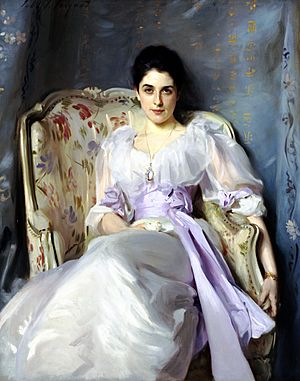Clan Agnew facts for kids
Quick facts for kids Clan Agnew |
|||
|---|---|---|---|
| Clann Mac a' Ghnìomhaid | |||

Crest: An eagle issuant and reguardant Proper.
|
|||
| Motto | CONSILIO NON IMPETU ("By Council, not by Force") | ||
| War cry | Agnew! | ||
| Profile | |||
| Region | Lowlands | ||
| District | Dumfries and Galloway | ||
| Animal | Eagle | ||
| Chief | |||
 |
|||
| Sir Crispin Agnew | |||
| 11th Baronet of Lochnaw | |||
| Historic seat | Lochnaw Castle | ||
|
|||
Clan Agnew (which in Gaelic is Clann Mac a' Ghnìomhaid) is a Scottish clan. A clan is a group of families linked by a shared ancestor and a common name. This clan comes from Galloway in the Scottish Lowlands.
Contents
History of Clan Agnew
Where the Agnew Name Comes From
The name Agnew likely comes from the Normans, a group of people from Normandy in France. They were part of the Agneaux or Aygnell family. It's thought that the Agnews first lived in England, then moved to Ireland around 1365. There, they became known as the Lords of Larne. Later, in the mid-14th century, they moved to Lochnaw in Scotland.
The first time the Norman name "Aigneus" was recorded in Scotland was around 1200. A person named William des Aigneus was a witness to an important document signed in Liddesdale.
Some people also suggest the name comes from the Celts of Ulster (in Ireland). These were the O'Gnimh, who were poets for the O'Neill family. They later changed their name to Agnew. This idea suggests the Agnews might share ancestors with Clan Donald, another famous Scottish clan.
The Agnews in the 15th and 16th Centuries
In 1426, Andrew Agnew of Lochnaw was given land and control of Lochnaw Castle. This was a special grant from William Douglas. In 1451, Andrew was made the Sheriff of Wigtown. This important role is still held by his family today.
Patrick Agnew, the 4th leader of Lochnaw, died soon after the Battle of Flodden. He might have been hurt in the battle. Later, in 1547, Andrew Agnew, the 5th leader, was killed at the Battle of Pinkie. He was fighting against the English.
The Agnews in the 17th Century
Sir Patrick Agnew was a Member of Parliament (MP) for Wigtownshire from 1628 to 1633, and again from 1643 to 1647. In 1629, he was given the title of a Baronet of Nova Scotia. This was a special honor from the King. Sir Patrick married Lady Anne Stewart, whose father was the first Earl of Galloway.
When Sir Patrick died in 1661, his oldest son, Andrew, became the next leader. Andrew also became an MP for Wigtownshire. In the 1650s, while Scotland was joined with England, he was made Sheriff of both Kirkcudbright and Wigtown.
The Agnews in the 18th Century

Sir Andrew Agnew of Lochnaw, the 5th Baronet, married a relative named Eleanor Agnew. They had many children, twenty-one in total! Sir Andrew was a brave soldier. He led the 21st Foot regiment (which later became the Royal Scots Fusiliers) against the French. This happened at the Battle of Dettingen in 1743.
King George II of Great Britain, who was the last British king to lead soldiers in battle, spoke to Sir Andrew. The King said that French cavalry had gotten too close to his regiment. Sir Andrew famously replied, "Yes, please your Majesty, but they didna win back again." This meant the French soldiers didn't escape. Sir Andrew later became a Lieutenant General and Governor of Tynemouth Castle.
During the Jacobite rising of 1745, Clan Agnew stayed loyal to the British Government. Sir Andrew defended Blair Castle, the home of the Duke of Atholl, against the Jacobite forces. His soldiers were almost starving. But then, Charles Edward Stuart (Bonnie Prince Charlie) told the Jacobite forces to go back to Inverness. This was to meet the army of Prince William Augustus, Duke of Cumberland. You can read more about this at the Siege of Blair Castle article.
The Agnews in the 19th Century

Sir Andrew Agnew, 7th Baronet (1793–1849) was an MP for Wigtonshire from 1830 to 1837. He was a strong supporter of laws to make people observe the Sabbath (a day of rest). He married Madeline, whose father was Sir David Carnegie.
Sir Andrew Agnew, 8th Baronet married Lady Louisa Noel. She was the daughter of the 1st Earl of Gainsborough. He served in the 93rd Highlanders in Canada. He also became an MP for Wigtonshire.
Main Agnew Family Branches
The Clan Agnew has several important family branches:
- The Agnews of Croach or Lochryan: These are descendants of William, the second son of Andrew Agnew, 2nd of Lochnaw. Today, they are known as the Wallaces of Lochryan.
- The Agnews of Sheuchan: These come from Patrick, the third son of Sir Patrick Agnew of Lochnaw, 1st Baronet. Their last female heir, Margaret, married John Vaus. He took the name Vans-Agnew in 1757.
- The Agnews of Kilwaughter: This branch is from near Larne in Northern Ireland. Their exact connection to the Lochnaw Agnews isn't fully known. But evidence suggests they are related.
- The Agnews of Dalreagle: These are descendants of Alexander Agnew, a son of Sir Andrew Agnew of Lochnaw, 3rd Baronet. A famous member of this branch was Major General Patrick Alexander Agnew. He served in the Honorable East India Company.
Clan Chief
The current leader, or Scottish clan chief, of Clan Agnew is Sir Crispin Agnew of Lochnaw. He is the 11th Baronet and also a King's Counsel (a senior lawyer) and Rothesay Herald (an official who deals with coats of arms). His heir, who will take over after him, is Mark Agnew of Lochnaw. You can find the family tree of the chiefs in the Red Book of Scotland.
Castles Connected to Clan Agnew
- Lochnaw Castle was the main home of the Clan Agnew chief. The family sold it in 1948. It is now owned privately. The castle is also known for its fishing.
- Galdenoch Castle was built between 1547 and 1570. It is now a ruin and part of Galdenoch Farm. This castle was the home of the Agnews of Galdenoch. They were descendants of Gilbert, the second son of Sir Andrew Agnew, 5th of Lochnaw. Gilbert owned Galdenoch in 1574.
See also
- Agnew (surname)

